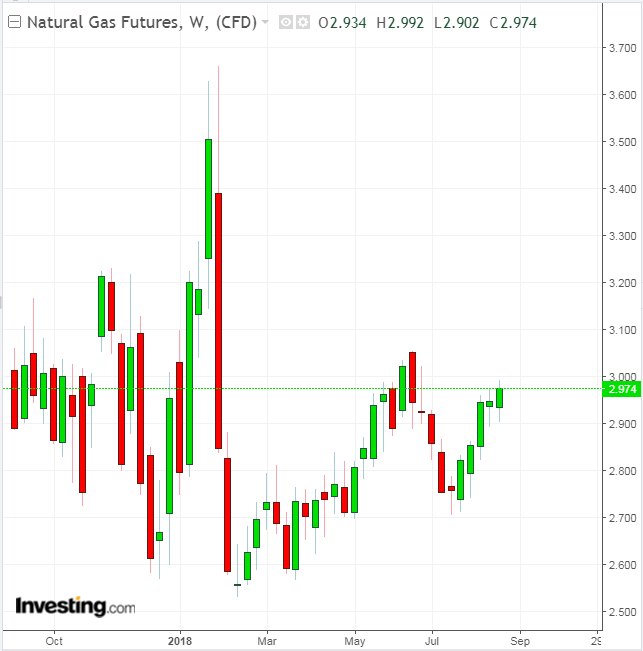It’s building up to be one of most suspenseful commodity markets with an outcome none can quite predict as yet. US natural gas prices are at an inflection point, with summer cooling demand waning and winter heating yet to kick in.
Almost everyone can agree with that. What no one knows for sure is whether the market should stay put, continue rising or give back a chunk of recent gains to reflect its state of uncertainty.

“The market is relatively quiet today after this morning’s storage report only elicited a moderate response,” Daniel Myers of Houston-based energy consultancy Gelber & Associates wrote Thursday after the latest weekly supply-demand statistics on natural gas released by the US Energy Information Administration.
At an injection of 48 billion cubic feet (bcf), the stock build for the week ended August 17 came in squarely within analysts’ expectations. Yet, it was historically below the five-year average of 52 bcf for weekly injections. In fact, for seven weeks out of the past nine, the addition of gas into underground salt caverns in the United States—after what was left from powering summer air-conditioning demand—has underwhelmed. And while summer heat is on the decline, there have been more warmer-than-usual days lately even as near-term weather forecasts show temperatures could be normalizing soon.
Analysts In A Quandary
This has left analysts in a quandary as to where prices ought to be. At Thursday’s settlement of $2.964 per million British thermal units, the September delivery contract for natural gas on the New York Mercantile Exchange was nearly 20 percent below the 2018 high of $3.661 per mmBtu, achieved on January 29. For the year, the market was up 0.4 percent, retaining a modest gain, as gas bulls stay hopeful of highs above $3 once winter heating demand kicks in.
That price action made natural gas a “Strong Buy” on Investing.com’s daily technical outlook. While Level 3 Fibonacci resistance, the strongest, for September gas was at $3.007, the potential upside has often proven to be higher. With the contract trading firmly above the 200-day moving average of $2.843, no immediate triggers for selling were visible on the daily technical outlook.
That jars with the expectations of some analysts who see the immediate trend as being lower. “Despite these somewhat bullish elements, production continues to hover near records and weigh on prices,” Gelber’s Myers wrote. “There is a sense that the recent rally doesn’t have much room to run beyond the $3 level given robust production, and the longer prices are inactive below this mark, the more difficult it will be to muster the energy to climb further.”
ADM Investors Services had a similar view. “Resistance should increase as the market pushes up towards the $3.000 level especially with record production and increased trade length over the last few weeks in the news,” ADMIS wrote in a Thursday commentary on gas.
“The bear camp will be quick to point out that production continues to grow and a sub-par injection today might be needed to stave off a quick setback to $2.90.”
Mixed Weather Forecasts Cloud Outlook
Dominick Chirichella of the DTN-owned Energy Management Institute in New York said mixed weather forecasts were clouding analysts’ judgment on gas pricing. “With the weather now pointing to above normal temperatures over most of the country east of the Rockies the injections for the coming week are not likely to result in any net changes to the deficit,” Chirichella wrote on Thursday.
“The latest short-term temperature forecast issued today is less supportive than the forecasts issued yesterday. The forecast is projecting a slight narrowing of the warming trend. The call on natgas for cooling related demand may not be as strong as originally thought,” he said.
“The eight to fourteen-day forecast is more supportive than the shorter-term projection as the above normal temperature area is less severe. The forecast could see cooling related demand decrease during this forecast period,” he added.
